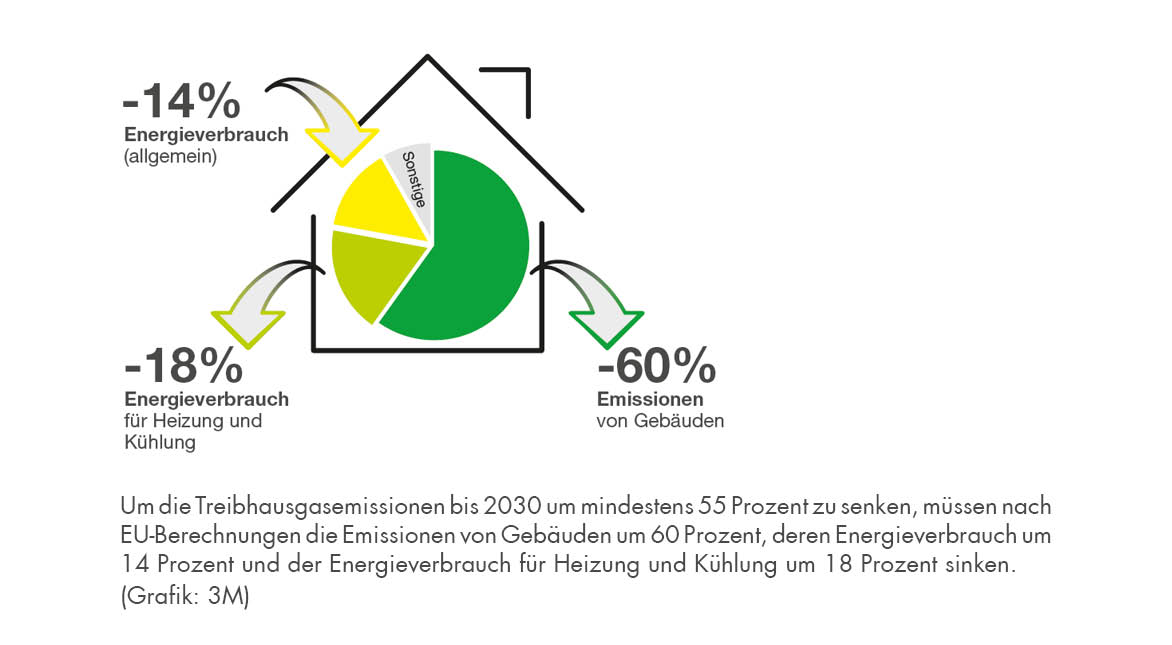Europe launches "Renovation Wave": ecosphere makes valuable contribution
The task: increase energy efficiency in buildings, solve the renovation backlog in old buildings, reduce emissions, achieve climate targets
A good 75 percent of Europe's building stock is considered to be in need of major energy refurbishment. But too little modernization is taking place: The current renovation rate of one percent of buildings per year is far too low to achieve the EU's climate targets. The EU-wide "Renovation Wave" initiative is intended to help implement the necessary renovations in existing buildings more quickly. What can be done in Germany?
Solution approaches
1. More speed in energy-efficient refurbishment
According to the German Energy Agency (dena), the annual renovation rate in Germany is currently only a good one percent2. There are 18.9 million residential buildings nationwide, 15.7 million of which are detached and semi-detached houses - where energy consumption per square meter is particularly high, according to dena.
Buildings from the 1950s to 1970s in particular, which were built before the first Heat Insulation Ordinance, generally have a very poor energy standard. Effective building insulation and modern heating technology should be the central building blocks for effective energy refurbishment. According to dena, "Fully refurbished residential buildings [...] already achieve consumption values that are almost on a par with new buildings."3
2. Public buildings as a model
Prioritized and ecologically sustainable renovation of public buildings such as schools, hospitals or administrative buildings is one of the focal points and thus also a possible use of funds from the EU "Renovation Wave". According to § 4 of the GEG (Building Energy Act 2020), the renovation of the federal and state building stock has exemplary character4 and supports, for example, the goals of a climate-neutral administration. In particular, so-called "lighthouse projects" with a high media presence, such as listed buildings, have a special role to play.
3. Intensification of promotional measures
The design options in the national implementation of the EU "Renovation Wave" must be used and advertised in the sense of an incentive policy, and utilization of the funds provided must be ensured.
A contribution from maxit: ecosphere - a new way of thermal insulation
1. Speed of implementation
Products from maxit can contribute to innovative and sustainable building materials in many ways. This also enables new insulation materials that offer significant advantages over conventional insulation in the areas of recycling, fire protection, appearance and flexibility. maxit ecosphere is a solution based on innovative materials but well-known application methods. Not only is the facade insulation of buildings conceivably simple, but it also increases the speed of processing (no gluing, dowelling, leveling of the substrate by means of leveling and sub-plastering) with the same or reduced use of personnel.
2. High insulation effect
The special feature of ecosphere is the innovative combination of mortar and glass: Glass bubbles, microscopically small and highly insulating hollow glass spheres, are bound in a dry mortar. The purely mineral and resource-saving building material (thus also no microplastics) can be easily sprayed onto the facade using familiar processing methods and has a particularly high insulating effect.
3. Sustainability
After use, the building material can be reused and recycled in the sense of a closed-loop economy. By dispensing with construction sand, a raw material that is dwindling worldwide, valuable resources are also saved.
4. Listed buildings
The good workability also as interior insulation without preceding leveling work of the substrate enables the quick energetic renovation also of listed buildings, where the façade must not be changed.
5. Use of automation
The provision of the innovative insulation material in reusable building material silos simplifies construction site logistics, while the possibility of spraying speeds up the application of the heat-insulating layer. In addition, work is already underway on digital processing methods to enable the insulation to be applied by robots in the future - an important aspect in view of the shortage of skilled workers, also in the construction industry.
Recognition by the Federal President:
At the "Deutscher Zukunftspreis 2020", the German President's prize for technology and innovation, the field-proven thermal insulation material maxit ecosphere was among the TOP 3 nominations.
Sources:
1 Across Europe, greenhouse gas emissions are to fall by at least 55 percent by 2030, and by 2050 Europe is to be climate-neutral. To achieve the first target by 2030, emissions from buildings would have to fall by 60 percent, their energy consumption by 14 percent and energy consumption for heating and cooling by 18 percent. Achieving the target is made more difficult by the high number of buildings constructed more than 20 years ago. |
bundesregierung.de: „Mehr Klimaschutz – klimaneutrale EU bis 2050“
2, 3 Deutsche Energie-Agentur dena (German Energy Agency): „dena-Gebäudereport: Sanierungsrate weiterhin viel zu gering“
4 geg-info.de: „Bundesgesetzblatt Part I No. 37“
5 Compared to conventional insulating plasters. maxit ecosphere thermal conductivity of λ10, dry, mat < 0.040 W/(m*K) in dry state.
6 European Comission (2020): " A Renovation Wave for Europe" | European Comission (2020): JRC report “Achieving the cost-effective energy transformation of Europe’s buildings” | IRP (2020): "Resource Efficiency and Climate Change" | UNEP (2020): "Emissions Gap Report"

